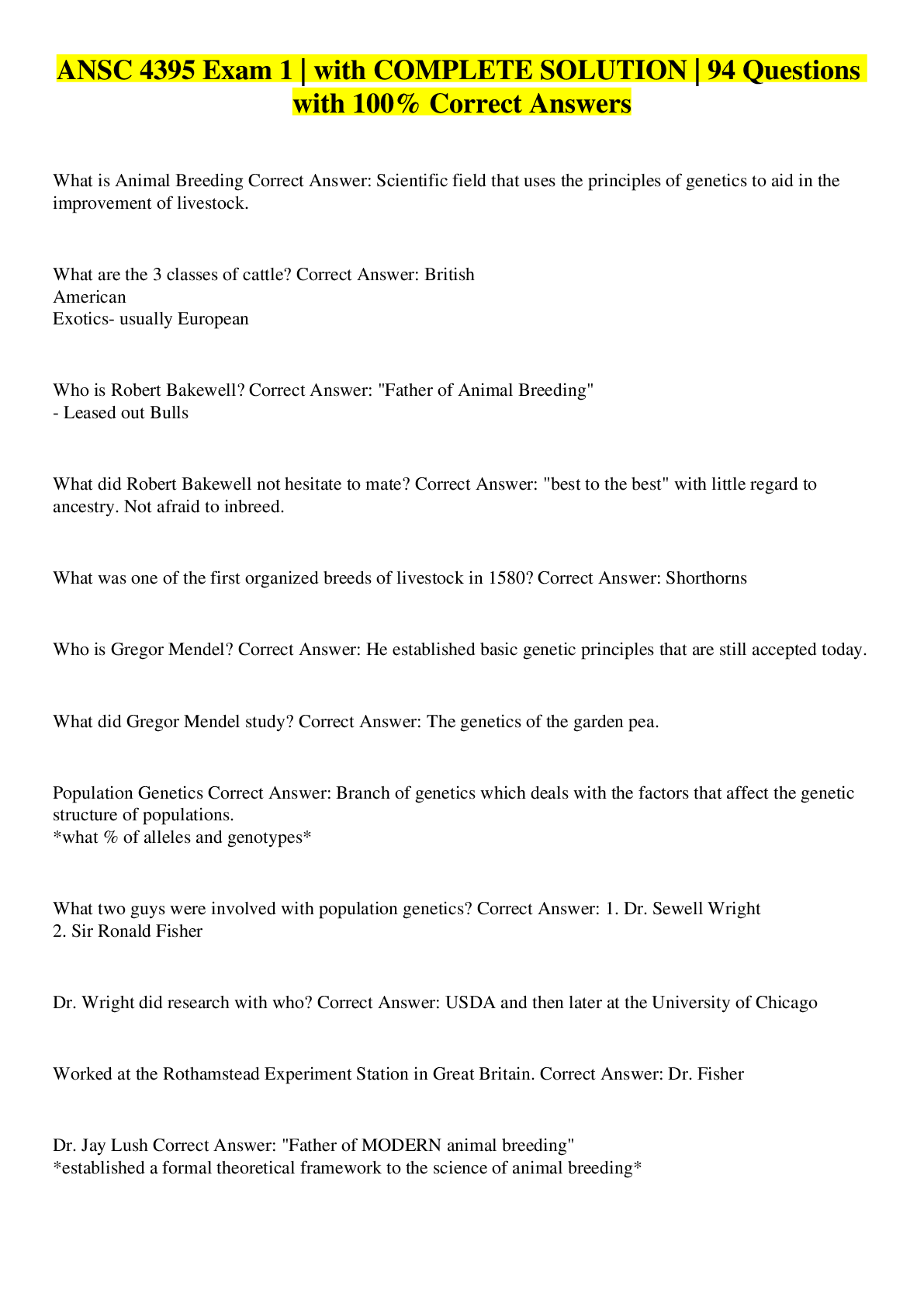Astro 1 - Exam 3
Document Content and Description Below
Astro 1 - Exam 3
what is the sun comprised of? - ✔✔73% hydrogen 25% helium
why is the sun stable? - ✔✔outward force of gas pressure; inward force of gravity
Where does the gas pressure in t
...
he sun come from? - ✔✔nuclear fusion reactions in the core at
temperatures of 15 million degrees
What is the diameter of the sun compared to earth? mass? luminosity (compared to 100W
lightbulbs? - ✔✔diameter-109x; mass-333,000; luminosity- 4 x 10^24
What percent of mass in the solar system comes from the sun? - ✔✔99.9%
how long has the sun been shining? how much longer will it shine? - ✔✔4.5 billion years; 5.5
billion years
what are sunspots? - ✔✔slightly cooler regions on the sun's surface
what causes sunspots? how long are their cycles? - ✔✔magnetic activity preventing hot material
from rising to that region. they have 11 year cycles
what comprises helium-4? What does it release? What is it called? - ✔✔4 protons combine to
make helium-4 (2 protons, 2 neutrons); produces gamma rays; it is called the proton-proton chain
What is the first step in Nuclear fusion? - ✔✔two protons stick together and one changes into a
neutron to produce deuterium (1 proton and 1 neutron)
What is the second step in Nuclear fusion? - ✔✔deuterium plus proton makes helium-3 (2
protons and 1 neutron bound together)
What is the third step in nuclear fusion? - ✔✔two helium-3 molecules combine to make helium4 and 2 protons
When is energy created in Nuclear fusion? - ✔✔in every step
Where does the energy in Nuclear fusion come from? - ✔✔E= mc^2 because the mass of helium
is 4 less than the mass of 4 protons
What are the layers of the sun from inside to out? - ✔✔core, radiative zone, connective zone,
photosphere, chromosphere, flare, prominence, corona, solar wind
What is the core of the sun like? - ✔✔at center; high density and temperature; where nuclear
reactions occur and gamma rays produced
What is the radiative zone of the sun like? - ✔✔photons are repeatedly reabsorbed
and emitted, and the energy of an individual photon
can take on average 170,000 years to pass through
What is the connective zone of the sun like? - ✔✔hot gas rises and cold gas sinks;
light traverses in 1 week
What is the photosphere of the sun like? - ✔✔temperature 5780K; the surface that we see;
photons have been converted to visible wave- length, see granules due to convection bringing
ma- terial up and down in cells
What is the chromosphere of the sun like? - ✔✔red or orange color; temperature 4500K; we see
through this to the photosphere
What is the flare of the sun like? - ✔✔eruption coming out of Sun due to magnetic activity
What is the prominence of the sun like? - ✔✔hoop shaped eruption out of Sun due to magnetic
activity
What is the corona of the sun like? - ✔✔low density; temperature 1 million K; visible during
solar eclipse
What is the solar wind of the sun like? - ✔✔charged particles coming from Sun's sur- face;
permeate whole solar system
What is luminosity? - ✔✔the absolute power output at the source
What is brightness? - ✔✔apparent output as observed at some distance
What determines how bright a star appears based upon its luminosity? - ✔✔inverse square law
What is the inverse square law? - ✔✔B= L/4πd^2; b-brightness, d-distance, L- luminosity
if two stars have the same luminosity and one is 10 times further away than the other, how bright
will it appear? - ✔✔it will appear 1/10^2 as bright which is 100 times fainter
What is the parallax method and what is it used for? - ✔✔used to measure distance; view stars
from two locations on opposite sides of the sun (6 months apart). these locations are on opposite
sides of the sun.
What is the baseline of the parallax method? - ✔✔1 AU is the radius of the orbit of earth around
the sun
At what angle does the star appear to move relative to distant stars in the parallax method? -
✔✔the star appears to move (relative to distant stars) by an angle 2 times that of the parallax
angle
how do you determine distance in parsecs? - ✔✔D= 1/p; p- parsecs in arcseconds;
Why is a star that appears fainter sometimes closer than a star that appears brighter? -
✔✔because the star the appears closer is more luminous
lower mass stars: What was the suns history? - ✔✔stellar nursery, protostar, main sequence, red
giant, planetary nebula, white dwarf
lower mass stars: what are failed stars? - ✔✔brown dwarfs, have mass less than 8% of the sun
and never heat enough to have nuclear reactions in their core
lower mass stars: what is a planetary nebula? - ✔✔ejected envelope of a low to intermediate
mass star
lower mass stars: what is the end state? - ✔✔white dwarf; held up against gravity by pressure of
electrons; size of earth
more massive stars: short or longer life on main sequence? - ✔✔shorter
more massive stars: What fuel is used? - ✔✔helium burning, then carbon burning, then onion
shell burning, then swelling to red supergiant
more massive stars: What does it stop burning at and why? - ✔✔stops burning at iron because
iron is very stable and reactions involving iron do not produce energy
more massive stars: How does it end? - ✔✔type II supernova with core left behind; supernova
makes elements heavier than iron, including gold and silver
more massive stars: what happens to the core? - ✔✔the core is 1.4-3 solar masses and becomes a
neutron star=radius of 5-6 km, city sized
more massive stars: what if the core is > 3 solar masses - ✔✔it becomes a black hole,
infinitesimal radius; infinite destiny
black holes: Where do they come from? - ✔✔it is the end state of a high mass star (> 40 solar
masses), left behind after a supernova explosion
black holes: can anything escape a black hole? can light? - ✔✔the gravity of collapsed (very
dense) object is so large that even light cannot escape
black holes: do black holes suck things in? - ✔✔black holes do not suck things in; if you are far
enough away from them they act like normal objects withe the same mass
black holes: what is the event horizon? - ✔✔the sphere around a black hole from within nothing
can escape
black holes: what can be used to measure the mass of a black hole? - ✔✔the speed of the orbit of
a star in a binary star system with a black hole
black holes: what would happen to a clock if if it was falling in a black hole? - ✔✔intense
gravity of a black hole warps space so that a clock would appear to slow as it falls down
black holes: what happens to object falling into a black hole? - ✔✔tidal forces are created near a
black hole and objects are stretched because the force on the nearest part is so much larger than
the force on the farthest part
black holes: what is at the center? - ✔✔a singularity, a point of infinite destiny
what happens at the end of its life with if a star begins with < 8 solar masses? - ✔✔the core
becomes a white dwarf- collapse stop because of degeneracy pressure of electrons- radius same
as earth
what happens at the end of its life with if a star begins with 8-40 solar masses? - ✔✔the core
becomes a neutron star- collapse stops because of degeneracy pressure of neutrons- radius of 5-6
km
what happens at the end of its life with if a star begins with > 40 solar masses? - ✔✔the core
becomes a black hole- collapse does not stop- mass concentrated at singularity
When, where and by whom was the first extrasolar planet discovered? - ✔✔when-1992; wherein orbit around a dead neutron star; cannot support life; by whom- Penn State Prof. Alex
Wolszczan
What were many of the planets discovered in the late 1990's and early 2000's like? - ✔✔planets
around the mass of Jupiter, that are very close to their stars
How many planets has the Kepler mission discovered using the transit method? - ✔✔thousands;
the brightness of the star decreases due to the planet passing right in front of it.
How does the transit method find the distance of the planet to its star? What does this
information help us discover? - ✔✔using Kepler's law . P^2 = a^3; it helps discover i the planet
is in the hospitable zone and the amount of drop in the stars brightness helps us discover the size
of the planet
how many extrasolar planets have been discovered in the habitable zones around their stars? -
✔✔a dozen
what is a habitable zone? - ✔✔region around a star where liquid water could be present on a
planets surface
Where would the habitable zone be on a less massive star? - ✔✔closer to the star
Where would the habitable zone be on a more massive star? - ✔✔further away from the star
Is life found in extreme conditions on Earth? - ✔✔yes, dark- ness, high radiation, acidic,
underground, in methane ice, extreme heat
What is drakes equation? what is it used for? - ✔✔N =R∗×fp ×ne ×fl ×fi ×fc ×L (p,e,l,i,c are
subscripts); method used to estimate the number (N) of communicating/ technological
civilizations in our galaxy
What is R* in Drake's equation? - ✔✔rate of star formation, number of stars forming per year in
our galaxy, around one solar mass per year
What is f(subscript) p in Drake's equation? - ✔✔percentage of stars that form planets
What is n (subscript)e Drake's equation? - ✔✔average number of planets that could support life
for each star
What is f(subscript)l Drake's equation? - ✔✔percentage of those planets where life occurs
What is f (subscript) i Drake's equation? - ✔✔percentage of those planets where intelligence
develops
What is F(subscript)c Drake's equation? - ✔✔percentage of intelligent species that
communicates
What is L Drake's equation? - ✔✔average lifetime of a communicating species
What are the properties of a star? - ✔✔luminosity, mass, size, temperature, and age
What affects the luminosity of a star? - ✔✔size and temperature directly affect luminosity; larger
size = larger light-emitting area = greater luminosity;
higher temperature = greater luminosity
Where are main sequence stars located on the H-R diagram? - ✔✔they form a band from the
lower right across the upper left
What are stars on the main sequence burning as fuel? - ✔✔hydrogen into helium
for stars on the main sequence does higher temperature= higher luminosity? - ✔✔yes
Where do red dwarfs (cool, faint, and small) fall on the H-R diagram? blue giants (hot, bright,
and large)? (main sequence) - ✔✔red dwarfs (cool, faint, and small) on lower right; blue giants
(hot, bright and large) on upper left
What determines where on the main sequence a star lives, and what the main sequence lifetime is
for the
star? - ✔✔mass; more-massive main sequence stars are on the upper left of H-R diagram; masses
range from about 0.1 to 100 times the mass of the Sun; sizes range from 0.1 to 15 times the
radius of the Sun
Where does luminosity range from on the main sequence stars (compared to the sun)? -
✔✔luminosities of main sequence stars range from 10^−3 to 10^6 times that of the Sun
for main sequence stars, how does the age range from those stars? - ✔✔age ranges from few
million years for more massive stars to much more than 14 billion years (age of the universe) for
less massive stars; REMEMBER, the more massive stars use their greater fuel supply more
rapidly
What are red giants and supergiants NOT on the main sequence like? - ✔✔burning helium not
hydrogen anymore; starting to die; size is large, so they are luminous even though they are
relatively cool
What are white dwarfs NOT on the main sequence like? - ✔✔hot, small and dim, so fall on
lower left of H-R diagram; dying stars
Can you identify on the H-R diagram - ✔✔hot and cold stars; blue and red stars
high and low luminosity stars
large radius and small radius stars
high mass and low mass stars
stars converting hydrogen to helium at their cores
red giants and white dwarfs
stars that will have a long or short lifetime
What is the H-R diagram? - ✔✔Hersprung-Russell diagram
What color are cooler stars? hotter stars? - ✔✔cooler stars- redder; hotter stars- bluer
on the H-R diagram what axis is surface temperature on? - ✔✔horizontal axis, increasing to the
left
How is temperature measured on the H-R diagram? - ✔✔using the spectral class
how do spectral classes of stars run from hotter to cooler on the H-R diagram? what is the
acronym for this? - ✔✔OBAFGKM; oh, be a fine guy/girl, kiss me
how is spectral class determined on the H-R diagram? - ✔✔using the absorption spectrum,
where absorption lines from different chemical elements with different levels of ionization arise
at different temperatures
What axis is luminosity expressed on in the H-R diagram? - ✔✔vertical axis, increasing to top;
ex- pressed in terms of the luminosity of the Sun, a solar luminosity
What is the closest star and how far away is it? - ✔✔Alpha centauri, 4.3 million light years away
or 1.35 parsecs, from the sun
Is the nearest star to the sun a singular star system? - ✔✔no it is a triple star system; the brightest
member similar to the sun
What are most of the nearest stars like and where do they fall on the H-R diagram? - ✔✔Most of
the nearest stars are cool and dim and fall on the lower right of the H-R diagram; this is because
most stars have these properties.
What is the brightest star in the nighttime sky? how massive is it compared to the sun? is it a
singular star system? - ✔✔sirius is twice as massive as the sun. its companion is a white dwarf
how do the brightest stars fall on the H-R diagram? where do they fall? - ✔✔brightest stars have
more varied properties, red and blue, low and high luminosity, with some on the lower right of
the H-R diagram, but others near where the Sun is, some on the upper left, and some on the
upper right (red giant region)
are the brightest stars always the closest? - ✔✔brightest stars tend to be biased towards stars that
have large luminosities, so that they appear bright to us even at large distances; we simply can't
see low- luminosity stars if they are too far away
What is luminosity? - ✔✔the absolute power output at the source
What is brightness? - ✔✔apparent output as observed at some distance
What determines how bright a star appears based upon its luminosity? - ✔✔inverse square law
What is the inverse square law? - ✔✔B= L/4πd^2; b-brightness, d-distance, L- luminosity
if two stars have the same luminosity and one is 10 times further away than the other, how bright
will it appear? - ✔✔it will appear 1/10^2 as bright which is 100 times fainter
What is the parallax method and what is it used for? - ✔✔used to measure distance; view stars
from two locations on opposite sides of the sun (6 months apart). these locations are on opposite
sides of the sun.
What is the baseline of the parallax method? - ✔✔1 AU is the radius of the orbit of earth around
the sun
At what angle does the star appear to move relative to distant stars in the parallax method? -
✔✔the star appears to move (relative to distant stars) by an angle 2 times that of the parallax
angle
how do you determine distance in parsecs? - ✔✔D= 1/p; p- parsecs in arcseconds;
Why is a star that appears fainter sometimes closer than a star that appears brighter? -
✔✔because the star the appears closer is more luminous
[Show More]
Last updated: 2 years ago
Preview 1 out of 15 pages









.png)



















